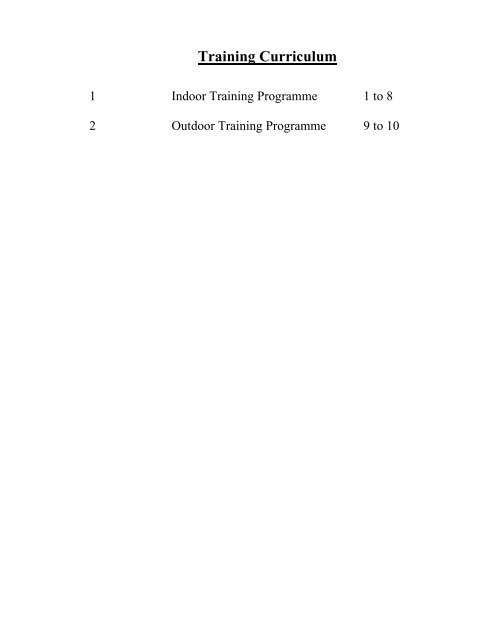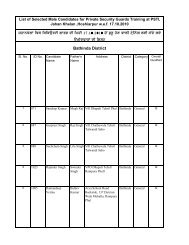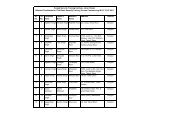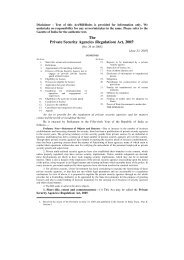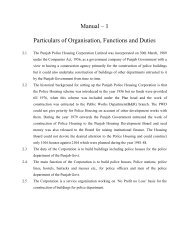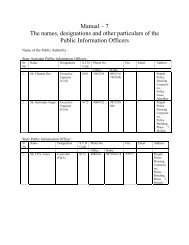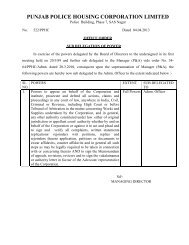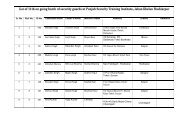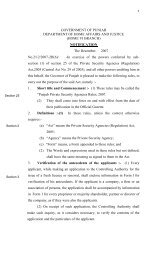Syllabus for Security Guard - Punjab Police Housing Corporation
Syllabus for Security Guard - Punjab Police Housing Corporation
Syllabus for Security Guard - Punjab Police Housing Corporation
Create successful ePaper yourself
Turn your PDF publications into a flip-book with our unique Google optimized e-Paper software.
Training Curriculum<br />
1 Indoor Training Programme 1 to 8<br />
2 Outdoor Training Programme 9 to 10
Indoor Training Programme Schedule<br />
1 Date of Commencement<br />
2 Duration of Course 60 Days<br />
3 Sunday/Gazetted Holiday<br />
4 Total No. of Working Days<br />
5 Total numbers of weeks<br />
6 Days assigned to Testing &<br />
Evaluation.<br />
7 Field Visits<br />
Indoor Training Subjects :<br />
1. Legal and Procedural Provisions related to <strong>Security</strong>.<br />
2. Vital <strong>Security</strong> Operations and their Practical Methodology.<br />
3. Role of <strong>Security</strong> Personnel in Contingency Management.<br />
4. Use of Computer/Electronic Appliances in <strong>Security</strong> Arrangements.<br />
5. Public Dealing and Self-Development.<br />
6. General Knowledge and Awareness about Current Events.<br />
Working Hours and Credit Weightage of different Indoor Training<br />
Subject :<br />
Subjects Weightage Working<br />
Hours<br />
Legal and Procedural Provisions related to 20% 38 80<br />
<strong>Security</strong>.<br />
Vital <strong>Security</strong> Operations and their Practical 25% 47 100<br />
Methodology.<br />
Role of <strong>Security</strong> Personnel in Contingency 20% 38 80<br />
Management.<br />
Use of Computer/Electronic Appliances in 15% 29 60<br />
<strong>Security</strong> Arrangements.<br />
Public Dealing and Self-Development. 10% 19 40<br />
General Knowledge and Awareness about 10% 19 40<br />
Current Events.<br />
Total:- 100% 190 400<br />
Grading Pattern<br />
80% and above marks - ‘A’<br />
70% to 79% marks - ‘B’<br />
60% to 69% marks - ‘C’<br />
50% to 59% marks - ‘D’<br />
Below 50% marks - Fail<br />
Total<br />
Marks <strong>for</strong><br />
Evaluation
Details of the Field Visits<br />
1. Visit to an Industrial Premises.<br />
(Sonalika Hoshiarpur, JCT Chohal Near Hoshiarpur)<br />
2. Visit to a Campus Assessed Sensitive from <strong>Security</strong> Point of View.<br />
(PAP Campus, Jalandhar/BSF Campus, Jalandhar)<br />
3. Visit to a Bank, Petrol Pump, Shopping Mall and Hotel Complex.<br />
4. Visit to a Venue of VIP Public Meeting.<br />
5. Attachment with distt. police <strong>for</strong> one day to learn traffic regulatory and<br />
parking arrangements.
Period-wise Details of Topics of Indoor Studies<br />
Subject:- Legal and Procedural Previsions Related to <strong>Security</strong>:- (38 Periods)<br />
Sr.<br />
Topic-wise Details<br />
Periods<br />
No.<br />
1. Introduction and Scope 02<br />
2. Rudimentary knowledge of Indian Penal Code, right to private 05<br />
Defence, procedure <strong>for</strong> lodging first in<strong>for</strong>mation report in the<br />
police station, Arms Act (only operative sections), Explosives Act<br />
(operative sections).<br />
3. Different procedural provisions related to FIR and role of <strong>Security</strong> 04<br />
Personnel prior to take-over by <strong>Police</strong>.<br />
4. Hierarchical Structure of Army, Para-military Forces, <strong>Police</strong> and 04<br />
Magistracy.<br />
5. In-depth study of the provisions of the Private <strong>Security</strong> Agencies 03<br />
Act and Model Rules-2006.<br />
6. Arms Licensing procedure and checking of the Arms Licencees 02<br />
7. Study of the provisions related to illegal trespassing and role of 03<br />
<strong>Security</strong> <strong>Guard</strong> in preventing trespass and getting legal action<br />
initiated.<br />
8. Duties of a <strong>Security</strong> <strong>Guard</strong> at the Scene of Crime/Arson prior to 02<br />
<strong>Police</strong> Intervention.<br />
9. Record keeping, Report writing and Incident Reporting by a 04<br />
<strong>Security</strong> <strong>Guard</strong>.<br />
10. Role of a <strong>Security</strong> <strong>Guard</strong> in getting Preventive action launched 03<br />
through Local <strong>Police</strong> in anticipation of Breach of Public Order.<br />
11. Procedure to be adopted <strong>for</strong> getting to the antecedents of a 02<br />
suspected person verified.<br />
12. Provisions pertaining to grant of Passport/Visa and authorization 02<br />
of the <strong>Security</strong> <strong>Guard</strong> <strong>for</strong> checking Passport/Visa entries.<br />
13. Provisions pertaining to the action required to be taken by a 02<br />
<strong>Security</strong> <strong>Guard</strong> in Lost and Found cases and to act as trustee of<br />
recovered property be<strong>for</strong>e its final disposal through established<br />
channels.
Subject:- Vital <strong>Security</strong> Operations and Practical Methodology. (47 periods)<br />
Sr.<br />
Topic-wise Details<br />
Periods<br />
No<br />
1. VIP <strong>Security</strong>- its Nature, Scope and Operational Tools and Techniques. 04<br />
2. Threat Perception Assessment and analysis of the factors determining the 02<br />
extent of threat.<br />
3. Protective Measures to be adopted <strong>for</strong> Personal <strong>Security</strong> at the following 05<br />
places:-<br />
i) Residence/Place of stay.<br />
ii) Public Meeting.<br />
iii) During Road and Rail Journeys.<br />
iv) While on the move on foot<br />
v) At a halting point enroute.<br />
vi) While intermingling with public.<br />
vii) At the Air-port/Helipad.<br />
4. Detailed theoretical discussion about the Limitations and Potentialities of 10<br />
Anti-sabotage Checking Equipments followed by practical training in their<br />
handling, operations, maintenance and minor adjustments.<br />
5. Operational Guidelines <strong>for</strong> the following <strong>Security</strong> related activities:-<br />
08<br />
i) Access-control.<br />
ii) Anti-sabotage checking.<br />
iii) Surveillance.<br />
iv) Shadowing.<br />
v) Identification of Narcotics, Weapons, Explosives and Improvised<br />
Explosive Devices.<br />
vi) Basics of Bomb-disposal and Area Sanitization Procedures.<br />
vii) Identification of Suspect from his Body-language.<br />
viii) Techniques of Over-powering a Suspect to pre-empt strike.<br />
6. Through Orientation about the following:-<br />
08<br />
i) Beat-Patrolling.<br />
ii) Point-duty.<br />
iii) Visual cover.<br />
iv) Protective cordoning.<br />
v) Watch and Ward duty.<br />
vi) Regulation of smooth flow of vehicles after a public meeting/party etc.<br />
vii) Organizing regulated parking to prevent choking of vehicular flow.<br />
viii) To handle public address system <strong>for</strong> regulatory/cautionary assignments.<br />
7. <strong>Security</strong> Imperatives <strong>for</strong> Event Management:-<br />
05<br />
a) Advance <strong>Security</strong> Liaison<br />
b) Installation of security/regulatory paraphernalia <strong>for</strong> handling crowds<br />
during mega-events to prevent stampede.<br />
c) Strategic manning of vital points <strong>for</strong> guarding of huge crowds.<br />
d) Handling and control of unruly elements.<br />
e) Preventive measures needed to be taken to <strong>for</strong>e-stall eve-teasing,<br />
pick-pocketing, snatching, drunken brawls etc.<br />
8. How to prove to be an effective Personal <strong>Security</strong> <strong>Guard</strong> in the face of grave<br />
threat from the following:-<br />
a) Terrorists.<br />
b) Kidnappers.<br />
c) Gangsters/Rowdy Elements.<br />
d) Mobsters.<br />
e) Robbers and Dacoits.<br />
f) Insider Conspirators.<br />
05
Subject : Role of <strong>Security</strong> Personnel in Contingency Management (38 periods)<br />
Sr.<br />
Topic-wise Details<br />
Periods<br />
No.<br />
1 Introduction about different contingent situations, their 04<br />
magnitude and response of <strong>Security</strong> Personnel in such<br />
situations.<br />
2 Attitudinal orientation <strong>for</strong> effective handling of Emergencies. 02<br />
3 Role of First Responders in the following emergent situations :- 06<br />
a) Road mishaps<br />
b) Rail accidents<br />
c) Fire in crowded place<br />
d) Flash-floods<br />
e) Earth-quake<br />
f) Bomb-blast<br />
g) Toxic/Radio-active/Emissions<br />
h) Medical Emergency<br />
i) Building-collapse<br />
j) Stampede<br />
k) Attack/bite by animal<br />
l) Electric shock<br />
4 Modalities of co-ordinative role of <strong>Security</strong> Personnel during 02<br />
crisis situations<br />
5 Instruments/equipments used <strong>for</strong> First-aid and their efficacy in 02<br />
different emergency situations.<br />
6 Elementary knowledge about Life saving techniques. 02<br />
7 Rudimentary skills <strong>for</strong> handling trauma victims in transit. 02<br />
8 Role of <strong>Security</strong> Personnel in containing Panic Reaction and 02<br />
restoring normalcy.<br />
9 Pre-emptive role of <strong>Security</strong> personnel to <strong>for</strong>e-stall mis-haps. 02<br />
10 Involvement of <strong>Security</strong> Personnel in distress mitigation ef<strong>for</strong>ts. 02<br />
11 Role of security-guards in providing special assistance to old, 01<br />
infirm, women, children etc. during emergency situations.<br />
12 Supportive role of <strong>Security</strong> Personnel in rescue and relief 02<br />
operations of larger magnitude.<br />
13 An introduction to standard operational procedures used in 02<br />
evacuation of disaster victims.<br />
14 Advance planning and preparation of SOPs <strong>for</strong> tackling 02<br />
emergencies at the place of duty.<br />
15 Responsibility of a <strong>Security</strong> <strong>Guard</strong> in risk detection and timely 01<br />
reporting to the concerned agency.<br />
16 Elementary knowledge about different types of fire fighting 02<br />
equipments, their handling, operations and maintenance/<br />
replenishment schedule on monthly audit basis.<br />
17 Response of <strong>Security</strong> <strong>Guard</strong> to disaster alarm signals and his 01<br />
role in prompt dissemination of the implications of alarm<br />
signals.<br />
18 Advisory role of <strong>Security</strong> guard in giving timely <strong>for</strong>e-warning 01<br />
about potential accidental occurrences.
Subject : Use of Computer/Electronic Appliances in <strong>Security</strong> Arrangements<br />
(29 periods)<br />
Sr.<br />
Topic-wise Details<br />
Periods<br />
No.<br />
1 Introduction to Computer, its accessories and their 02<br />
maintenance and functioning.<br />
2 Knowledge about computer software, data processing 04<br />
and storage and retrieval through different software<br />
packages and programmes.<br />
3 Basic orientation about the use of password and other 04<br />
security features to prevent hacking and<br />
corruption/distortion of data-base.<br />
4 Accessing the internet <strong>for</strong> downloading requisite 01<br />
in<strong>for</strong>mation.<br />
5 Use of e-mail and Web Camera features on computer. 02<br />
6 Use of Close Circuit T.V. network <strong>for</strong> <strong>Security</strong> Monitoring 02<br />
and its practical operation.<br />
7 Rudimentary knowledge about different Bugging Devices 02<br />
and their security implications.<br />
8 Verifying the identity of a person through Photo-Identity 01<br />
Cards, e-cards etc. with special emphasis on the<br />
possibilities and security risk potential of their misuse.<br />
9 Cargo/baggage checking with the help of X-ray 01<br />
monitoring machines.<br />
10 Checking of Cell-phones and other personal electrical/ 02<br />
electronic devices to prevent their misuse <strong>for</strong> detonating<br />
improvised explosive devices.<br />
11 Handling and use of Wireless communication devices <strong>for</strong> 03<br />
security duties.<br />
12 Use of Bullet proof shields/jackets, Night Vision Devices, 03<br />
micro recorders and cameras, magnifying<br />
glasses/binoculars and flash/security lights <strong>for</strong> security<br />
duties.<br />
13 Introductory orientation about bio-metric mode of access 01<br />
regulation and control.<br />
14 Introduction to smart e-cards used <strong>for</strong> different types of 01<br />
business/monetary transactions and their potential<br />
misuse <strong>for</strong> fraudulent purposes.
Subject:-<br />
Public Dealing and Self-Development. (19 periods)<br />
Sr.<br />
Topic-wise Details<br />
Periods<br />
No.<br />
1. Character-traits of a pleasant personality and their role in 01<br />
enhancing professional effectiveness.<br />
2. Identification of undesirable personal habits and manners 01<br />
and the ways and means to keep them under check.<br />
3. Proper turn-out/dress-up and cultivation of appropriate 01<br />
manners and etiquettes.<br />
4. Parameters of desirable social behaviour and conduct and 01<br />
the ways to acquire the same through conscious ef<strong>for</strong>ts.<br />
5. Basic attributes of the professional code of conduct <strong>for</strong> 01<br />
<strong>Security</strong> Personnel.<br />
6. Mess-manners. 01<br />
7. Niceties/Courtesies to be observed while interacting with:- 01<br />
a) Ladies.<br />
b) Senior Citizens.<br />
c) Patrons/Clients.<br />
d) Officers/Executives.<br />
e) Young Children<br />
f) Physically Challenged persons.<br />
g) Colleagues/Peers.<br />
h) Juniors/Subordinates.<br />
8. How to maintain high standards of personal health and 01<br />
hygiene.<br />
9. How to properly handle and use modern gadgets/sanitary 01<br />
fittings installed in public/private toilets/lavatories/kitchens<br />
common utility areas etc.<br />
10. Role of ethics and morality in shaping up individual<br />
01<br />
personality.<br />
11. How to gain co-operation, trust and support from fellow 01<br />
workers in a group.<br />
12. Importance of self-discipline, pro-activeness and serviceorientated<br />
01<br />
attitude in personal and professional dealings.<br />
13. An overview of the public/private/corporate sector work 01<br />
culture and need to make behavioural adjustments<br />
accordingly.<br />
14. How to contribute towards the creation of a relaxed work 01<br />
environment.<br />
15. Proper management and utilization of time <strong>for</strong> personal and 01<br />
professional satisfaction.<br />
16. Confidence Building and Over coming shyness when facing 02<br />
the Interview.<br />
17. How to enhance concentration of mind and focus on work 01<br />
<strong>for</strong> better quality output.<br />
18. General In<strong>for</strong>mation about Bank Transactions and<br />
Railways/Air Bookings.<br />
01
Subject:- General Knowledge and Awareness about Current Events (19 periods)<br />
Sr.<br />
Topic-wise Details<br />
Periods<br />
No.<br />
1. Important Events of Indian History 02<br />
2. Elementary knowledge about History Culture and<br />
03<br />
Traditions of <strong>Punjab</strong>.<br />
3. Important Geographical Facts and Figures 02<br />
4. General in<strong>for</strong>mation about leading personalities at the 02<br />
national and state level.<br />
5. Main facts related to Science and Technology 02<br />
6. General knowledge about Sports, Films and Fine Arts. 03<br />
7. Current issues and events. 02<br />
8. Elementary knowledge about Indian Constitution and<br />
functioning of Local-self Govt.<br />
03
Outdoor Training Programme Schedule<br />
1 Duration of Course 60 Days<br />
2 Sunday and Gazetted Holidays<br />
3 Total No. of Working Days<br />
4 Total numbers of weeks<br />
5 Days assigned to Testing, Evaluation<br />
and Field Visits.<br />
Outdoor Training Subject :<br />
1. Physical Fitness Exercises .<br />
2. Endurance Practice.<br />
3. Proper Wearing of Dress.<br />
4. Saluting/Greeting.<br />
5. Proper Body Movements and Basics of Marching.<br />
6. Un-armed Combat.<br />
7. Fundamentals of <strong>Security</strong> Skills/Practices: (Practical Field Demonstrations)<br />
i) Access Control/Frisking<br />
ii) Anti-sabotage Checking<br />
iii) Cordoning and Sealing<br />
iv) Evacuation<br />
v) Surveillance<br />
vi) Chasing, Overpowering and Immobilization of a Mobster/Suspect<br />
vii) Identification of I.E.Ds and Explosive/Narcotic Material.<br />
viii) Body Search, Premises Search and Area Search.<br />
ix) Defensive Driving.<br />
x) Working of Anti-sabotage Checking Gadgetry.<br />
xi) Role of Sniffer Dogs in <strong>Security</strong> Operations.<br />
xii) First-aid.<br />
xiii) Type and Techniques of Patrolling.<br />
xiv) Handling a Mob-attack.<br />
xv) Handling and Operation of Wireless Communication Equipments.<br />
xvi) Handling and Operating Basic Fire-fighting Equipments.<br />
xvii) Close quarter combat Techniques.<br />
xviii) Cordoning and Providing <strong>Security</strong> Cover to a Threatened Person in<br />
Crowded Places.<br />
8. Musketry Handling and Firing of personal weapon.
Working Hours and Credit Weightage of Different Outdoor Training<br />
Subject :<br />
Subjects<br />
Weightage Working<br />
Hours<br />
Total<br />
Marks <strong>for</strong><br />
Evaluation<br />
Physical Fitness Exercises 25% 38 80<br />
Endurance Practice 8% 12 25<br />
Proper Wearing of Dress 8% 12 25<br />
Saluting/Greeting 11% 16 35<br />
Proper Body Movements and Basics of Marching 11% 16 35<br />
Un-armed Combat 6% 10 20<br />
Fundamentals of <strong>Security</strong> Skills/Practices:<br />
(Practical Field Demonstrations)<br />
i) Access Control/Frisking<br />
ii)<br />
Anti-sabotage Checking<br />
iii) Cordoning and Sealing<br />
iv) Evacuation<br />
v) Surveillance<br />
vi) Chasing, Overpowering and<br />
Immobilization of a<br />
Mobster/Suspect<br />
vii) Identification of I.E.Ds and<br />
Explosive/Narcotic Material.<br />
viii) Body Search, Premises Search and<br />
Area Search.<br />
ix) Defensive Driving.<br />
x) Working of Anti-sabotage Checking<br />
Gadgetry.<br />
xi) Role of Sniffer Dogs in <strong>Security</strong><br />
Operations.<br />
xii) First-aid.<br />
xiii) Type and Techniques of Patrolling.<br />
xiv) Handling a Mob-attack.<br />
xv) Handling and Operation of Wireless<br />
Communication Equipments.<br />
xvi) Handling and Operating Basic Firefighting<br />
Equipments.<br />
xvii) Close quarter combat Techniques.<br />
xviii) Cordoning and Providing <strong>Security</strong><br />
Cover to a Threatened Person in<br />
Crowded Places.<br />
25% 38 80<br />
Musketry Handling and Firing of personal weapon. 6% 10 20<br />
T O T A L:- 100% 152 320


